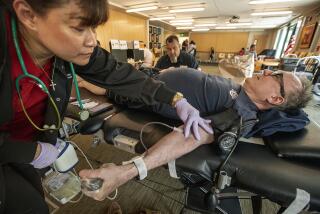Specter of AIDS Casts Cloud Over Transfusions
- Share via
WASHINGTON — Doctors are intensifying efforts to save blood and avoid transfusing the blood of strangers into their patients, taking such steps as salvaging blood during operations and asking people to donate their own blood before undergoing surgery.
Although the chances of contracting AIDS through blood transfusion currently are very low, the specter of the deadly disease has focused public attention on the safety of the U.S. blood supply and raised questions about the necessity of some transfusions.
About 12.1 million units of blood are transfused into about 3.5 million patients in the United States annually.
Unlike other blood components, oxygen-bearing, red blood cells cannot be heat-treated and therefore are more likely to remain contaminated with disease-causing viruses.
Current estimates of contracting the AIDS virus by transfusion range from one in 40,000 blood units to one in 1 million. However, the risk of being infected with the hepatitis virus is much higher, and may be one per 100 units for some types of hepatitis.
“Transfusion of homologous (donated by another person) red cells carries documented risks of infection and immune changes. Therefore, the number of homologous transfusions should be kept at a minimum,” said Dr. Tibor Greenwalt, head of an advisory panel that recently studied transfusions.
The panel, convened by the National Institutes of Health, emphasized the present system of blood donations by volunteers “will continue to be the mainstay” of transfusions.
But it added, “Alternatives will reduce the use of homologous transfusion to some extent and their development should be encouraged.”
One alternative gaining momentum in the wake of the AIDS epidemic is self-, or autologous, donation of blood. Although the practice of people giving their own blood in a series of donations prior to surgery is more than 160 years old, it declined after blood banks emerged in the 1940s.
At the Hoxworth Blood Center in Cincinnati, the number of patients self-donating blood before surgery jumped from 27 in 1981 to 1,807 in 1987.
Despite the increase, self-donation accounts for only 2% of blood donations nationwide. Hoxworth’s report blames poor participation on “the apparent reluctance of physicians to refer their patients.”
Added Concerns Told
In addition to worries about labeling mix-ups, the NIH panel said it fears self-donating patients may be more likely to be transfused than patients receiving blood from volunteer donors.
“If a patient puts blood in the blood bank and it belongs to the patient, it may be felt he should get it back no matter whether at that point he has lost any blood,” said panel member Dr. Jane Desforges of the New England Medical Center in Boston.
Another option is directed donation, in which someone who knows the patient and who has the same blood type donates units specifically for that patient.
“This is done assuming a patient can be a better judge of a safe donor (than a blood bank),” Greenwalt said. “There is absolutely no evidence directed donors are safer than volunteer donors.”
Apart from new donation strategies, the medical community is looking at alternatives to reduce the amount of blood needed for transfusions.
Much research has gone into developing materials other than hemoglobin-rich red cells to transport oxygen in the blood. But despite decades of work, no such substance is available for general use.
Possible materials for testing include perfluorochemicals--organic liquids capable of carrying large amounts of dissolved oxygen--and solutions of modified hemoglobin--the protein and iron compound in blood that normally carries oxygen.
“Even if it (an artificial substitute) does become practical, how much can we produce?” Greenwalt asked.
More promising from the committee’s standpoint are drugs to reduce blood loss during surgery.
Desmopressin may improve blood clotting and drugs that lower blood pressure may also cut blood loss. Studies also show a genetically engineered hormone, recombinant erythorpoietin, may increase hemoglobin levels in anemic patients.
One dramatic alternative is blood salvage. The procedure, in which blood lost during surgery is collected, “washed” and returned to the patient, works best for heart and orthopedic operations in which substantial blood is lost.
The technique is not recommended during cancer surgery or when there is a chance the blood may be infected. It is usually not cost effective in minor surgery in which little blood is lost.
“Intraoperative blood salvage appears to be safe in some applications . . . although current technology is costly because of disposables, equipment and personnel,” the NIH panel concluded.
The committee had more reservations about hemodilution, in which a large amount of a patient’s blood is removed just before surgery and the lost volume replaced with a cell-free substitute. After surgery, the stored blood is retransfused into the patient.
Although conceding some patients can be treated in this way, the panel cautioned, “Appropriate limits have not yet been established for its general use.”
More to Read
Sign up for Essential California
The most important California stories and recommendations in your inbox every morning.
You may occasionally receive promotional content from the Los Angeles Times.













